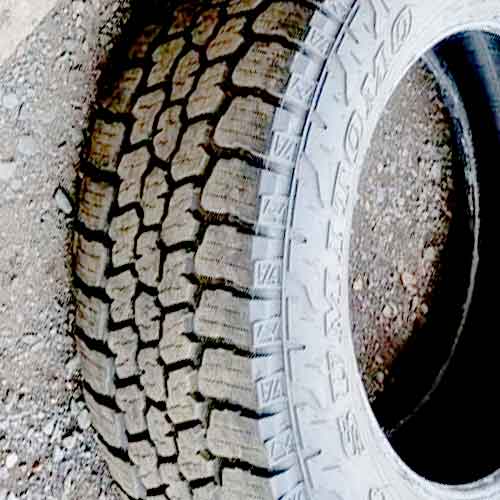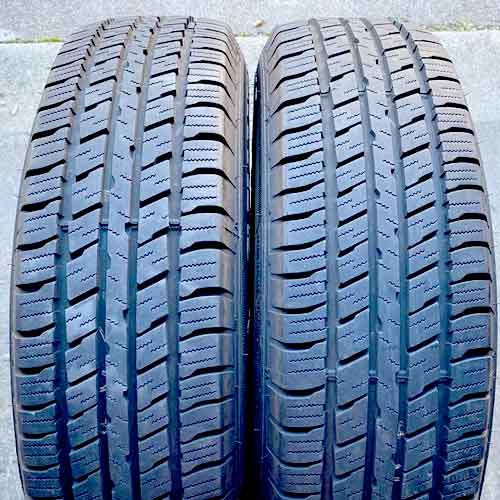Both these tires are form very different categories. The Sumitomo Encounter AT comes in as an all-terrain tire, while the Sumitomo Encounter HT, as the name suggests, is from what they call highway terrain. Let’s see how they compare next to each other. And which tire is better for you.

Table of Contents
Durability
Enhanced durability in tires necessitates a blend of cut and chip resistant rubber, coupled with robust internal construction.
Having said that, the Sumitomo Encounter HT tire’s internal build comprises a two-ply (or three-ply in LT sizes) polyester casing, undergirded by two broad steel belts, all reinforced with a spirally wound polyamide layer.
And this exact architecture is mirrored in its A/T counterpart as well.
But does this mean both tires exhibit equal robustness? Well, not really.
Although their construction may appear similar on paper, the Encounter A/T sports stronger underlying plies.
Additionally, this tire is equipped with a cut-resistant rubber, a feature its sibling lacks. And yes, its increased tread depth and rubber thickness contribute to an overall boost in durability.
Check out Detailed Review of Sumitomo Encounter A/T.
Tread Design
The Encounter AT from Sumitomo has 3 ribs in the middle and elongated shoulder lugs on the sides.

The sidewalls have minimal lugs, and the shoulder lugs are not staggered but have sharp edges.
These blocks are connected with tie bars for improved handling stability and have full depth interlocking sipes for good wet traction.
The inner ribs have pairs of blocks that are connected from beneath and create 4 longitudinal channels, with the inner ones being slightly narrower.
These blocks have biters on the edges and have a siping pattern that is unique compared to the shoulder lugs.
These lugs also have a secondary rubber layer underneath that connects with the shoulder lugs.
Overall, its very easy to see why this tire is more aggressive in comparison.
That’s why on the other side, the Sumitomo Encounter HT offers a more on road oriented design in comparison.

Starting things from the middle, the tire has 3 main ribs there, where the central most in narrower and is continuous (without lateral gaps).
Though id does have notches facing both sides, and full depth interlocking sipes.
The surrounding ribs, although make prominent blocks, they are also placed on a secondary continuous rib underneath.
They are equipped with groove notches and similar siping.
Lastly, looking at the outer ribs, there isn’t anything different here, you get to see similar siping pattern and traction notches.
Moreover, these lugs aren’t staggered and they also don’t make any sidewall lugs.
Tread Noise
Air is the main culprit when it comes to tread noise.
This is because the air particles mostly enter through the voids between shoulders (for the most part), and hit around the walls to generate tread noise.
So it makes sense why the Encounter A/T is a louder tire here.
On the other side, the Encounter H/T doesn’t allow as many air particles to enter, in the first place.
And the noise generated by some that still manage to enter, is mitigated by the tire’s variable pitch technology.
This tech basically focuses on making slight variations on the tread blocks, so that the air particles hitting them could generate different tones, which later try to cancel out each other.
Read More:
Are A/T tires noisy?
Directional Traction
When we talk about forward or “directional” traction, we’re looking at how well the tire grips the road when it’s moving straight ahead, and this is measured by how quickly the car can stop, or its “braking distance”.
Now let me tell you that the Sumitomo Encounter HT does really well in this area, meaning it can stop quickly and safely. Let me explain why.
So this tire has 3 ribs, or block columns, running down the middle, offering a very streamlined and straight moving pattern, which help it accelerate and brake more effectively.
Moreover, these ribs don’t features a lot of lateral gaps in between, reducing gaps and making sure as much of the tire as possible is in contact with the road.
And yes, one more thing, adding to the tire’s traction, these tread blocks also have beveled, or angled, edges which help to spread the weight of the car evenly when you brake.
The Sumitomo Encounter AT, on the other hand, clearly has bigger gaps between its tread blocks. And so needless to say, they offer less rubber contact with the road, limiting overall grip.
Lateral Traction
Lateral grip is calculated via lateral gravitational forces as the tire executes a turn. And its highly dependent on the shoulders and sidewalls of the tire.
This is because, as the tire corners, the weight on it shifts towards the tread sides.
Now, the Sumitomo Encounter HT does really well here too, thanks to its large contact area with the road and its strong sidewalls, which have two layers of reinforcement.
The Sumitomo Encounter AT, however, has tread blocks that can move around a bit during turning. This might make the steering feel less responsive, or slower to react.
Wet Performance
Wet performance comprises two main elements: grip and hydroplaning resistance. Both are crucial for displacing water from the tread effectively.
Hydroplaning
Hydroplaning is basically floating of the tire.
It happens when a thin layer of water gets between the tire and the road, causing the car to slide or skid.
So how to prevent this?
Well, with the help of grooves, that allow pathways for the water to leave out.
Fortunately, both tires here are pretty voided, and offer a lot of pathways for water to leave out quickly, so I rated both tires equally here.
Wet Grip
When it comes to gripping wet roads, the Sumitomo Encounter HT does better overall, thanks to having more thin slits, or sipes, across its tread.
These sipes basically suck water particles in, making the surface relatively dry, so that the rubber/biters can grip in more efficiently.
But the thing is, the Sumitomo Encounter AT doesn’t have as many sipes, and its tread is quite stiff.
This stiffness makes it harder for the sipes to flex and suck up water, which could make the tire less effective on wet roads.
So its a win for the Encounter HT.
Winter Traction
When it comes to winter performance, both tires showcase their all-season prowess, though still only the Sumitomo A/T comes with the 3 peak mountain snowflake rating.
So testing both tires in all kinds of snowy terrains, the Encounter A/T featured superior directional and lateral traction in both ice and fluffy snow.
Still, I was really impressed by the H/T variant showcasing commendable performance on packed up snow. I mean sure, the tire is lacking here comparatively, but its still good enough.
Basically the Encounter AT offers an array of full-depth sipes, and in-groove notches, gripping the icy surface at a microscopic level, in a much better way.
Fuel Consumption
The key determinant influencing fuel efficiency is the rolling resistance, calculated by considering the tire’s weight and its (rubber) adherence to the surface.
And upon evaluation, it becomes apparent why the Sumitomo Encounter HT delivers superior results.
The tire’s comparatively lighter structure applies lesser stress on the tread blocks, and its reduced tread depth curtails unnecessary flexing and bending of the lugs.
Basically the bending of the lugs is the main thing here, as their bending takes away the fuel energy, that could have used in to the rolling of the tire.
And that’s the very reason why the Sumitomo Encounter AT is taking the back seat here. It’s greater weight, combined with larger tread voids make its lugs more flexing.
Off Road Performance
While both the Sumitomo Encounter A/T and H/T tires are not specifically designed for extreme off-road conditions, their performance can be distinguished when they are put to the test across various types of terrain.
Soft Sand
Soft sand is challenging to navigate due to its tendency to cause tires to sink.
To counter this, tires are often deflated to increase their surface area and provide better flotation. Basically, you can say, by reducing air pressure, tires get lighter and less dense, so they float better.
Now although the Sumitomo Encounter A/T is heavier, it’s features sidewall lugs which spread out with lowered air pressure, and distribute that weight more evenly.
Moreover, it’s larger tread voids act as paddles, throwing sand backwards, generating forward motion.
Both of these are missing in its little brother.
Mud Tracks
In muddy conditions, the design and arrangement of tread’s lugs play a crucial role in ensuring traction. Let me explain why.
Mud basically, requires large spaces or channels to prevent accumulation and clogging, which could lead to a loss of traction, as mud simply slips on mud.
Having said that, the Sumitomo Encounter A/T, with its wider tread voids and interlocking central ribs, performs remarkably well here.
The tire’s wider voids provide a lot more space for mud to enter and exit, relatively, while its sharp edges and built-in biting elements provide the break up of the mud particles, so that they could pass out more easily.
In comparison, the lacking Sumitomo Encounter H/T struggles due to its longitudinally aligned ribs. These ribs basically don’t allow mud to leave out sideways.
Rocks And Gravel
When navigating rocky terrains, having grip from multiple angles is crucial, as climbing rocks can overturn the vehicle otherwise.
So it makes sense why its again a win for the Sumitomo Encounter A/T, as this tire is designed with an array of biting elements across various angles, providing grip in both longitudinal and lateral directions and enhancing its climbing capabilities.
These biters are missing in the H/T variant. And yes, this tire also lacks the necessary durability, which is a must on rocks, as its the most “puncturing” terrain.
Take Home Points
The Sumitomo Encounter H/T and A/T tires cater to different performance needs.
The Encounter H/T, with its optimized tread design, provides superior traction on paved roads, resulting in improved on-road comfort, better fuel efficiency, and longer tread life.
On the other hand, the Sumitomo Encounter A/T shines in off-road conditions across various terrains. It delivers impressive tread durability, especially for Light Truck (LT) sizes.
And its all-season compound also offers enhanced winter traction in deeper terrains, making it a versatile choice for those who frequently traverse off-road paths.